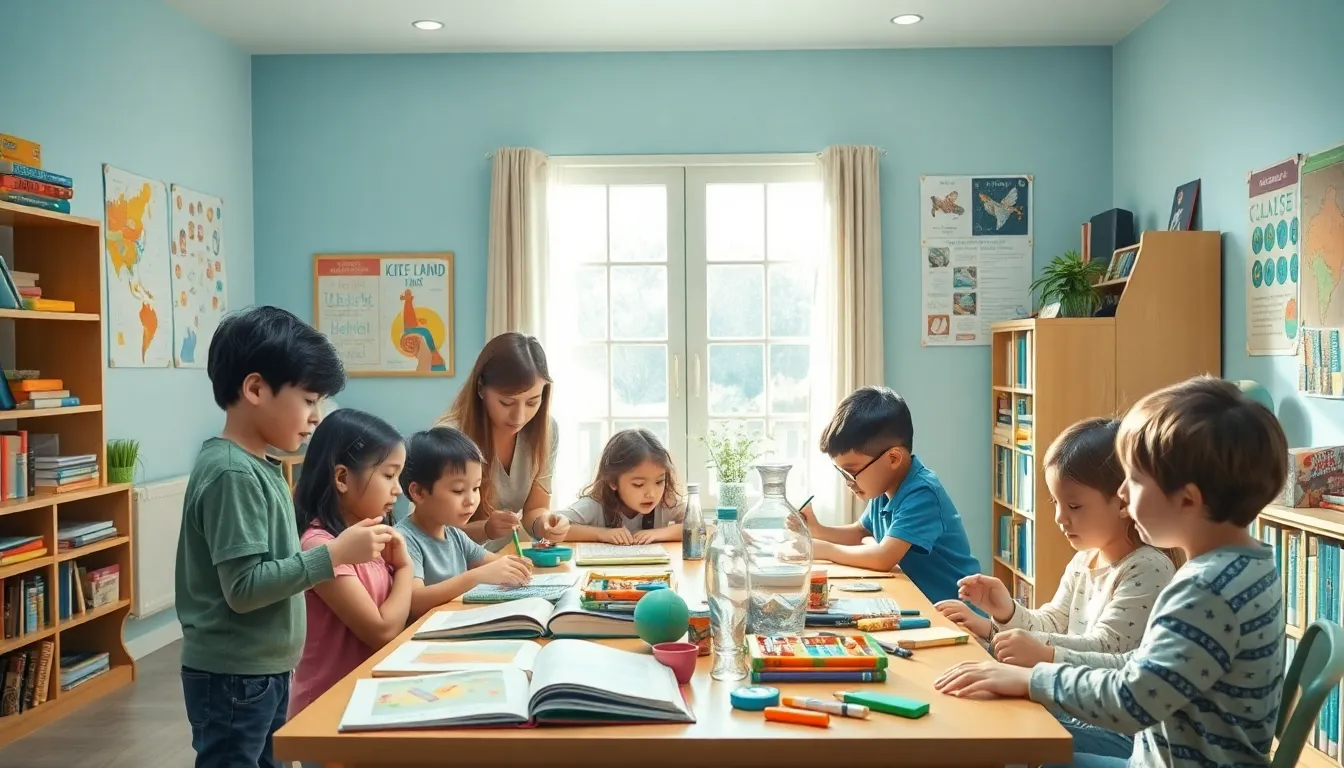Table of Contents
ToggleHomeschooling can feel like a wild rollercoaster ride, complete with unexpected twists and turns. Whether a family’s diving into this adventure for the first time or transitioning from one style to another, the journey is anything but boring. It’s a chance to embrace creativity, flexibility, and sometimes, a little chaos—because who doesn’t love a good surprise in the middle of math class?
Navigating these transitions requires more than just a change in curriculum; it’s about finding the right balance between structure and spontaneity. From figuring out how to keep kids engaged to managing their social lives, every step is a learning experience. So buckle up as we explore the ins and outs of homeschooling transitions, where each new chapter promises laughter, growth, and maybe a few “oops” moments along the way.
Understanding Homeschooling Transitions
Homeschooling transitions refer to significant shifts in a family’s educational journey. These changes can involve moving from traditional schooling to homeschooling or adjusting homeschooling styles as children grow.
What Are Homeschooling Transitions?
Homeschooling transitions encompass various changes in educational methods. These can include shifts in curriculum, classroom environments, or teaching strategies. Families might transition when a child reaches a new educational stage or when specific needs arise. Adaptation to these changes is crucial for maintaining an effective learning environment.
Why Are They Important?
Understanding the significance of homeschooling transitions offers insights into a child’s educational experience. These transitions can enhance flexibility, accommodating a child’s evolving interests and learning styles. They also foster resilience as families navigate challenges, enabling better support systems. Ultimately, adjusting to different homeschooling styles ensures families maximize learning potential and maintain engagement.
Common Reasons for Homeschooling Transitions

Transitions in homeschooling often arise from a variety of factors. Each reason reflects changing priorities and circumstances in a family’s educational journey.
Moving to a New Curriculum
Families frequently choose to switch curricula when current materials no longer meet their children’s needs. A curriculum that engages students at one stage might become less effective as their interests grow. New curricula can offer innovative approaches, align more closely with educational goals, or incorporate different learning styles. Trends in educational resources also influence these decisions, with families seeking programs that provide updated content, technology integration, or skills-based learning. Significant research supports that not all curricula suit every child, highlighting the importance of finding the right fit.
Changing Learning Environments
Learning environments often shift to better accommodate evolving educational requirements. Some families prefer to transition from a structured home setup to a more flexible co-op or hybrid model. Outdoor or community-based activities may be integrated to enhance social interactions. Moving to different physical spaces, such as a dedicated learning area or public library, can spark creativity and motivation. Each transition provides opportunities to explore new resources and experiences, enriching the overall educational experience for children. Adaptability in setting fosters an environment where learners feel engaged and supported.
Shifting Family Needs
Family dynamics frequently change, prompting adaptations in homeschooling approaches. Changes in work schedules, family size, or a child’s developmental milestones can lead to reassessment of homeschooling methods. Flexibility is crucial in responding to these shifting needs while maintaining educational continuity. Some families may require more support, such as tutoring, while others might explore independent or self-directed learning options. Balancing these factors ensures that the educational plan accommodates diverse needs, optimizing effective learning outcomes. Transitioning in response to family needs strengthens the commitment to provide the best educational experiences for children.
Strategies for a Smooth Transition
Transitions within homeschooling require careful planning and execution. These strategies can significantly ease the adjustment process for both students and families.
Preparing Students for Change
Students benefit from early discussions about upcoming changes. Introducing new curricula or teaching styles helps them feel included in the process. Creating a welcoming environment fosters positive feelings toward transitions. Encourage students to express their thoughts and feelings about the changes. Including visual aids or schedules can provide clarity. Implementing gradual adjustments allows students to acclimate comfortably. Engaging them in setting learning goals enhances their motivation.
Involving the Whole Family
Transitioning effectively involves everyone in the family. Discussing changes collectively encourages open communication. Families should participate in planning and decision-making to promote a sense of ownership. Assigning roles to family members tasks them with contributing to the transition. Sharing responsibilities helps distribute workload while supporting collaboration. Family meetings about schedules and activities build teamwork. Celebrating milestones together strengthens bonds and boosts morale.
Setting Realistic Expectations
Reality checks regarding the transition are vital. Establishing achievable goals keeps motivation high and reduces frustrations. Assessing progress regularly allows families to adapt as needed. Being flexible with timelines helps manage unforeseen challenges. Reminding family members that learning is a journey fosters patience. Celebrating small victories encourages persistence. Understanding that setbacks can occur creates resilience, ultimately enhancing the homeschooling experience.
Challenges of Homeschooling Transitions
Homeschooling transitions present unique challenges that families must navigate.
Emotional Adjustments for Students
Students often experience a mix of emotions during transitions. Anxiety may arise as they adjust to new routines or curricula. Parents frequently notice shifts in motivation or engagement, particularly if the new approach feels unfamiliar. It’s essential to validate these feelings and provide reassurance. Encouraging open conversations about their concerns boosts confidence and acceptance. Offering support through this emotional process fosters resilience and adaptability, helping students manage their feelings.
Academic Setbacks
Academic setbacks can occur during transitions. Families might face gaps in knowledge or inconsistency in learning pace. When switching curricula, the new material might not align perfectly with the child’s previous education. These mismatches can lead to frustration for both students and parents. Establishing a structured learning plan addresses these setbacks effectively. Providing supplemental resources or tutoring can also help bridge knowledge gaps, ensuring students remain on track. Recognizing that academic challenges are part of the transition can reduce stress and help families focus on growth.
Balancing Responsibilities
Balancing responsibilities proves challenging during homeschooling transitions. Parents often juggle teaching, household management, and other commitments. Changes in curriculum may require additional time for planning or outreach to resources like co-ops. It’s vital to create a schedule that accommodates these new demands. Prioritizing tasks and delegating age-appropriate responsibilities to siblings can alleviate pressure. Maintaining flexibility in daily routines fosters a supportive environment during transitions, encouraging a more manageable balance for the entire family.
Navigating homeschooling transitions can be a rewarding yet complex journey. Families have the opportunity to adapt their educational approaches to better suit their children’s evolving needs. Embracing flexibility and open communication fosters resilience and strengthens family bonds during these changes.
By understanding the unique challenges and celebrating milestones along the way, families can create a positive learning environment that encourages growth. Each transition serves as a chance to refine educational strategies and deepen the commitment to providing the best possible learning experiences. With patience and support, homeschooling can transform into a fulfilling adventure for both parents and children.







